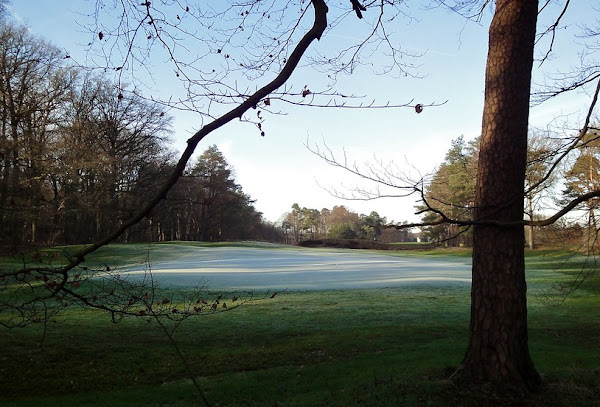Why Do Golf Courses Have Frost Delays? 'Footprinting'
If you've ever shown up at a golf course on a cold morning while the frost is still on the ground, then you know the frustration of waiting out a frost delay. Even if you are willing to tee off in the cold, the golf course staff won't let you until the frost has melted away. Why? What is it about frost that makes golf courses tell golfers, "You'll just have to wait until the frost disappears?"
The short answer: Walking on frosted golf course turfgrasses will kill the grass. In fact, within a few days, the grass will be dead in the shape of the golf shoes that trod upon the frosted ground. It's an effect called "footprinting," and it's much more severe the shorter the grass is. Hence, it is putting greens that are most badly affected when a golfer (or anyone else) ignores the frost delay and walks on the turf. The putting surface will likely soon be marked by a trail of brown (dead grass) footprints visible in the green (not walked upon) grass of the putting surface.
But why does frost have this effect on golf course grass, especially on putting green surfaces? Frost is frozen dew, and it is crystalline in structure — the ice is sharp and jagged at the small level of the turfgrass blades. The blades of grass themselves also freeze, since they are mostly made up of water.
When you walk across a putting green covered in frost (as the one in the photo above), those shards of ice puncture the blades, inside and out, causing cell membranes inside the blades to burst. No damage is immediately noticeable to the naked eye, but soon the grass in those footprints you left in the frost will start to wilt and die. Usually within 48 to 72 hours, the "footprinting" effect will be visible: your footprints now clear as dead, brown grass.
And that is why golf courses have frost delays: To make sure no golfers (or anyone else) is out there walking across the turfgrass while it is still frozen in frost.
Golf courses have some methods of combating footprinting. They can grow the putting green grass just a smidge higher, if they choose, because the taller the grass is, the better it can withstand frost damage. They can, if the air temperature is not too cold, wash away the frost with sprinklers or hoses, or turn fans on to blow across the greens and melt frost. If there are trees blocking early morning sun around greens, they can thin out the trees to reduce early morning shade.
And golf courses can catalog which greens are most affected by frost and, possibly, do some rerouting to get golfers playing while waiting for the affected greens to thaw. For example, if the front nine greens remain frosted longer than the back nine greens, a course can have everyone tee off their rounds on No. 10, giving more time for those front nine greens to thaw. If the first two holes are the ones most likely to frost, a course can start play on No. 3 that day. Those are options that, sometimes, are available.
But the main method of combating footprinting is the frost delay.
Related articles:
- Golf course striping: Do those stripes in the grass matter?
- Do golf courses paint the grass?
- The divot tool and how to use it
